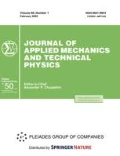Abstract
A theoretical and experimental analysis of the influence of the dispersed transition layer between a coating and a substrate on the development of deformation structures near the interface has been performed as part of an interdisciplinary study of the deformation and fracture of coating-substrate compositions under contact interaction. Elastic energy transfer from an indenter was simulated using excitable cellular automata taking into account the self-organization of translations and rotations of the structure near the interface. The effect of the transition layer between the coating and the substrate on the development of deformation structures during contact interaction with the indenter in three-point bending was studied experimentally using a TOMSC television-optical measuring complex.
Similar content being viewed by others
References
I. V. Kragel’skii, Friction and Wear (Mashinostroenie, Moscow, 1968) [in Russian].
I. V. Kragel’skii, “Friction as a Result of Repeated Deformation of Surface Layers,” Izv. Vyssh. Uchebn. Zaved., Fiz., No. 5, 119–127 (1958).
D. N. Garkunov, Triboengineering (Mashinostroenie, Moscow, 1989) [in Russian].
I. G. Goryacheva and M. N. Dobychin, Contact Problems in Tribology (Mashinostroenie, Moscow, 1988) [in Russian].
I. G. Goryacheva and Yu. Yu. Makhovskaya, “Modeling Friction at Different Scale Levels,” Izv. Ross. Akad. Nauk, Mekh. Tverd. Tela, No. 3, 117–127 (2010).
V. E. Panin and V. E. Egorushkin, “Deformable Solid as a Nonlinear Hierarchically Organized System, Fiz. Mezomekh. 14(3), 7–26 (2011).
V. E. Panin and V. E. Egorushkin, “Physical Mesomechanics and Nonequilibrium Thermodynamics As a Methodological Basis of Nanomaterials Science,” Fiz. Mezomekh. 12(4), 7–26 (2009).
V. A. Romanova and R. R. Balakhonov, “On the Role of Internal Interfaces in the Formation of Mesoscopic Strain Relief on the Free Surface of Loaded Metals,” Fiz. Mezomekh. 13(4), 35–44 (2010).
F. D. Murnaghan, Finite Deformation of an Elastic Solid (Wiley, New York, 1951).
D. D. Moiseenko and P. V. Maksimov, “Distributions of Stress and Strain on a Surface Layer-Substrate Interface: Simulation Based on a Stochastic Approach,” Fiz. Mezomekh. 8(6), 89–96 (2005).
V. E. Panin, V. M. Chernov, D. D. Moiseenko, et al., “Multilevel Modeling of Phenomena of Irradiation-Induced Swelling and Growth of Materials with Close-Packed Structure,” in Electron Microscopy and Multiscale Modeling: Proc. of the EMMM-2007 Int. Conf., Moscow, Russia, September 3–7, 2007 (Amer. Inst. Phys., Melville, 2007), pp. 102–117.
V. E. Panin, D. D. Moiseenko, P. V. Maksimov, and A. V. Panin, “Physical Mesomechanics of a Deformable Solid as a Multilevel System. 3. Inelastic Precursor of Plastic Shear Generation,” Fiz. Mezomekh. 9(5), 5–15 (2006).
V. E. Panin, I. Yu. Pochivalov, D. D. Moiseenko, et al., “Tribocontact in Friction Pairs As a Multilevel Hierarchically Organized System,” Fiz. Mezomekh. 13(6), 27–34 (2010).
V. E. Panin, A. V. Kolubaev, A. I. Slosman, et al., “Wear in Friction Pairs as a Problem of Physical Mesomechanics,” Fiz. Mezomekh. 3(1), 67–74 (2000).
V. E. Panin, V. A. Klimenov, M. P. Seifullina, et al., “Effect of Ultrasonic Treatment during Melting of Gas-Thermal Coatings on the Deformation and Fracture Behavior of Coating-Substrate Compositions in Three-Point Bending,” Fiz. Mezomekh. 7(2), 105–115 (2004).
Author information
Authors and Affiliations
Corresponding author
Additional information
Original Russian Text © V.E. Panin, D.D. Moiseenko, S.V. Panin, P.V. Maksimov, I.G. Goryacheva, C.H. Cheng.
__________
Translated from Prikladnaya Mekhanika i Tekhnicheskaya Fizika, Vol. 55, No. 2, pp. 148–158, March–April, 2014.
Rights and permissions
About this article
Cite this article
Panin, V.E., Moiseenko, D.D., Panin, S.V. et al. Mechanisms of elastic energy dissipation in the transition layer between a coating and a substrate under contact interaction. J Appl Mech Tech Phy 55, 318–326 (2014). https://doi.org/10.1134/S002189441402014X
Received:
Revised:
Published:
Issue Date:
DOI: https://doi.org/10.1134/S002189441402014X



